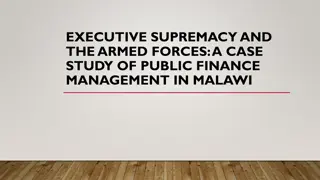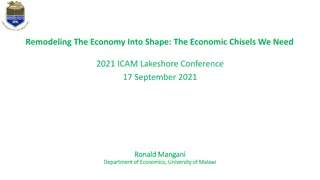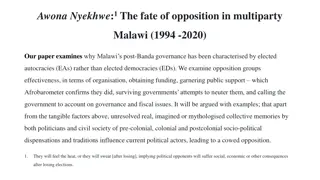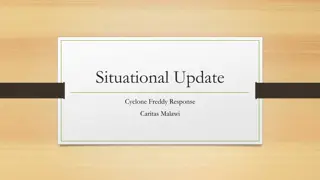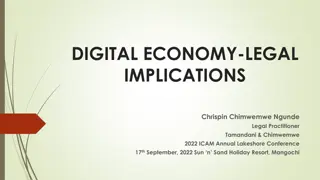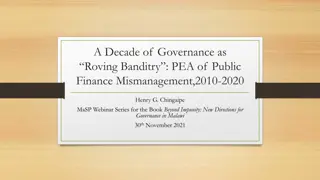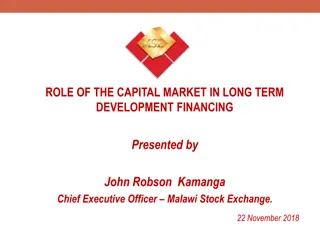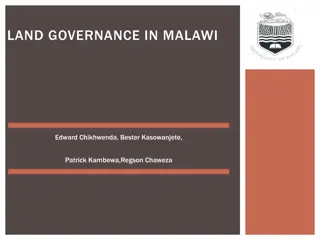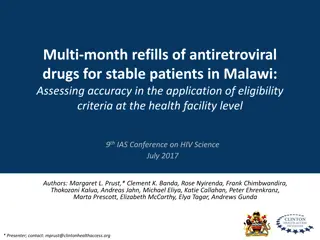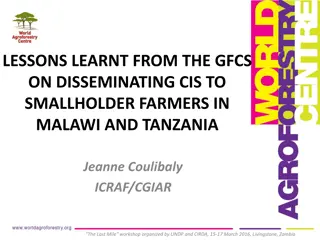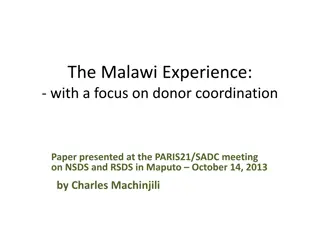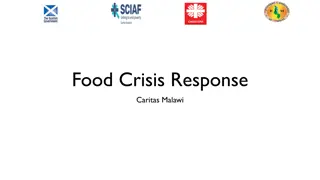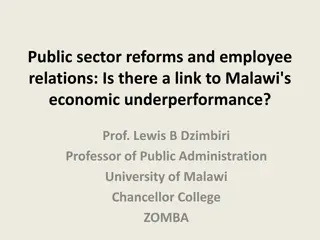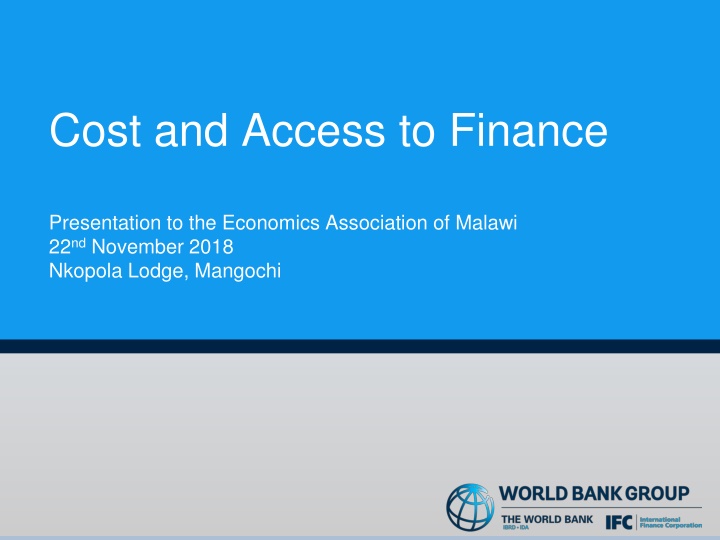
Access to Finance in Malawi - Understanding the Challenges
The presentation delves into the scope of financial access in Malawi, highlighting statistics, impediments to growth, and disparities in loan facilities. It draws comparisons with global standards and outlines strategies for enhancing financial inclusion and support for enterprises.
Download Presentation

Please find below an Image/Link to download the presentation.
The content on the website is provided AS IS for your information and personal use only. It may not be sold, licensed, or shared on other websites without obtaining consent from the author. If you encounter any issues during the download, it is possible that the publisher has removed the file from their server.
You are allowed to download the files provided on this website for personal or commercial use, subject to the condition that they are used lawfully. All files are the property of their respective owners.
The content on the website is provided AS IS for your information and personal use only. It may not be sold, licensed, or shared on other websites without obtaining consent from the author.
E N D
Presentation Transcript
Cost and Access to Finance Presentation to the Economics Association of Malawi 22ndNovember 2018 Nkopola Lodge, Mangochi
Economics is important for many areas of society. It can help improve living standards and make society a better place. Economics is like science in that it can be used to improve living standards and also to make things worse. Source: Google.com
Outline Defining access to finance Defining interest rate as proxy for cost of finance Interest rate composition Commonly used option to reduce cost of finance capping Experience and lessons from Kenya and other countries Alternative options Access to finance from the demand side Conclusion
Defining Access to Finance Access to finance - the ability by individuals or enterprises to obtain financial services, (credit, deposit, payment, insurance, and other services). The 2017 Global Findex database put it that 34 percent of adults in Malawi have an account at a financial institution, against 64 per cent for the world. Financial access measures include: the number of bank accounts per 1,000 adults, number of bank branches per 100,000 adults, the percentage of firms with line of credit (large and small firms), percentage of adult population that is financially included, formally served, banked, served by formal and informal institutions, etc. Evidence suggest that lack of access impedes growth and generates persistent income inequalities and poverty
Defining Access to Finance in Malawi according to FinScope Consumer Survey 33 % of adult population are banked 24 % have/use other formal (non bank) services/products 28 % have/use informal mechanisms to manage their finances 46 % have/use no financial products to manage their finances. If they save, they keep their money at home, and if borrow they only rely on family and friends
Defining Access to Finance in Malawi according to 2014 Malawi Enterprise Survey 93 percent of loans in Malawi required collateral and value of collateral needed for loan is as large as 293.6 per cent. 29.9 % of enterprises in Malawi cite access to finance as biggest obstacle to business operations. Only 26.7 % of enterprises indicate that they have a loan or line of credit with a bank Access to loan facilities or line of credit is skewed towards the large scale enterprises 43 percent of large enterprises utilize banks as a source of financing for working capital, compared to 22 percent for small scale. 65 percent of total investment is financed internally, while only 13.8 per cent is financed by banks. The rural based, the female headed, the non- exporting, and the domestic oriented firms seem to face more challenges with access to finance than their respective counterparts. The findings of the MCCCI are similar to those from the 2014 enterprise survey, and also consistent with the DB findings. Cost of finance is cited as one of the top three obstacles.
Interest Rates - a proxy for cost finance Kenya Tanzania Uganda Malawi 45.00 40.00 35.00 30.00 25.00 In general, banks use a combination of effective interest and non-interest income to cover operating costs and earn a profit 20.00 15.00 10.00 5.00 0.00 9/1/2005 7/1/2006 5/1/2007 3/1/2008 1/1/2009 9/1/2010 5/1/2012 3/1/2013 1/1/2014 9/1/2015 7/1/2016 5/1/2017 1/1/2004 7/1/2011 11/1/2004 11/1/2009 11/1/2014 Interest/lending rates are particularly high in Malawi Operating costs are the biggest contributor to the spread includes security, fraud, ATM related charges, diesel
Interest rate Composition Big challenge is that the lending rates in Malawi are high and spreads are large
a bit more information on cost of funds What are the key sources of funds being lent out Wholesale funds from large corporations o Bank lending is largely funded by deposits, and for the relatively newer banks, the bulk of which are from wholesale depositors (medium and large enterprises including investment firms). o The investment corporations have direct access to the primary market for government securities, and therefore able to secure rates close to or above T-bills and therefore influenced by the same and government borrowing. Retail/demand deposits account for over 50 % of total deposits and given the negligible interest rated paid on current accounts of less that 1 %, the effect of higher rates paid on savings and term deposits including wholesale funds my be largely mitigated Savings deposits this could be half of funds Interbank transactions although this is at 15 % (in recent wks) its effect on overall cost of funding is negligible (1 % of average daily funding source) Discount window navigates around policy rate of 16% - but total amount accessed through this window is low ( . also deposits from FCDAs, loans and advances) Cost of funds average about 4% to 7% per cent (in some isolated instances below 4% and up to 10%) (LRR built in) determined by source of funds, composition therein (deposit structure) as well as reliance on wholesale funding. Smaller banks tend to rely more on wholesale funds more and therefore have more costly funds.
Options to reduce cost of finance- capping Ceilings on lending rates (caps) are widely-used instruments in many countries around 76 countries worldwide Restrictions/caps vary substantially regarding what they cover and how they work Scope Broad (egg micro credit card) Narrow (egg pay day loans) Proponents of Interest rate caps aim to use this to protect consumers from usury to make credit cheaper and therefore more accessible. Number of ceilings Single ceiling Multiple ceiling Absolute cap Relative cap Type Fixed cap (benchmark + x) % points Relative cap (benchmark*x) Methodology Since 2011, at least 30 instances of new caps or tightening existing ones Benchmark Average market rate Policy Rate Above market rate Below market rate Binding Five instances when restrictions have been removed Fees Including fees Excluding Fees Annual Effective rate Separate cap on fees
Lessons from other countries on caps Interest rate caps are used by about17 countries in Africa Using bank-level panel data before and after the caps, it shows that this policy has resulted in unintended results most of the times: A significant decline in aggregate lending An increase in nonperforming loans A change in composition of lending away from small and medium enterprises and toward safer corporate clients A tendency by banks to shift away from offering interest on current account deposits to preserve their interest margins. These quantitative findings are supported by qualitative evidence through detailed interviews of commercial bank executives, and have important implications for economic growth and financial inclusion.
Experience and lessons from Kenya Interest rates before and after cap Switch in private sector credit Returns on Assets Kenya introduced interest rate caps in august 2016 Results - interest rate caps brought with them unintended negative consequences, making an already tough lending environment even more difficult Credit growth to private sector weakened, while lending to the government and lower risk large corporates increased The proportion of new borrowers fell Negatively affected small borrowers and SMEs credit share to SMEs reduced Narrower interest margins translated to declining profits, which in turn affected capital outlays TWO YEARS OF IMPLEMENTATION - THE BANKING ACT IS BEING AMMENDED TO REMOVE THE CAPS.
Experience and Lessons from Kenya The Central Bank of Kenya s vision to address concerns underlying high interest rates Adoption of customer-centric business models by banks technology, culture, products Risk based credit pricing Enhanced transparency and information disclosure financial literacy Entrenching an ethical culture in banks- Doing the Right thing A banking sector charter securing commitment from boards of banks to entrench a responsible and disciplined banking sector aiming at facilitating a responsible and disciplined credit market. The charter would have the following key components: Fairness: Ensuring credit risk pricing based on credit scores Transparency: Developing Cost of Credit website Financial Literacy: Targeted customer financial literacy initiatives Consumer Centric Business Models: banks to implement business models that are innovative, dynamic and responsive Financial Access: to increase financing to micro and small sized enterprises by at least a defined percentage within a time bound.
Access to finance from the demand side Most analyses on this topic emphasize on the supply side constraints - paying less attention to the demand side constraints that arise from the environment and SME inherent characteristics. Firm characteristics owner perceptions and other demand side challenges hinder potential and actual enterprises (especially SMEs) to access finance Entrepreneur characteristics Most SMEs are characterized by having a few or no collateralizable fixed assets SMEs have characteristics and attributes hinder their access to external finance Lack of skills to run and manage businesses Management practices Most SME owners exhibit aversion towards selling ownership control and that makes it difficult to access extra financing Local enterprising characteristics Most small firms are not accustomed to keeping books of accounts Potential firms are not able to develop business proposals that are bankable Business development services (BDS) needed to start and grow a business in order to be able to link with financial institution
Conclusion Interest rates are high and ability by majority of MSMEs to absorb finance is poor. High interest rates are coming mostly from the macro side due to high inflation rates But it is also a result of high operating costs, inefficiency, small base, lack of information and financial literacy, perception of risk It is necessary to do something about (banks needs to be realistic abut their costs) It would be necessary to ensure that the macros are in order. Recource to T-Bills should be under control. It would also be necessary for authorities to agree with the banking sector to set time lined targets for them to reduce inefficiencies, high operating costs, achieve higher customers base, deploy innovative banking models, be customer eccentric. Government should improve service delivery such as improvement of justice system, enhanced transparency and information disclosure financial literacy A number of programs are also needed to resolve the demand side challenges.



